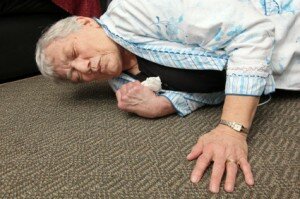Understanding Fall Risk Care as a Caregiver
 The risk for elderly patients when it comes to falling is great indeed. It is so very important to practice safety for out patients when it comes to fall risk. It only takes one fall and an elderly patient can become disabled, endure chronic pain, or die as a result. This is one area of care that we need to be VERY cautious in. We called upon expert Dr. Barbara Bergin Orthopedic Surgeon of Austin Texas to create a best practices when caregiving for a fall risk patient.
The risk for elderly patients when it comes to falling is great indeed. It is so very important to practice safety for out patients when it comes to fall risk. It only takes one fall and an elderly patient can become disabled, endure chronic pain, or die as a result. This is one area of care that we need to be VERY cautious in. We called upon expert Dr. Barbara Bergin Orthopedic Surgeon of Austin Texas to create a best practices when caregiving for a fall risk patient.
Who is at Risk for falls?
Frankly, everyone is at risk for falls, but it is the elderly who are at greatest risk for the obvious reasons; as we age our balance deteriorates, our muscles weaken, and our vision gets worse. These are all faculties which help us to prevent falls or recover from near misses and without them we are at greater risk.
Understanding the importance of protecting against elderly falls?
The injuries which result from falling in the elderly result in pain, disability, death and medical expense. Let’s just look at the impact of hip fractures alone. This devastating injury continues to result in early death and disability. 50% of patients over 65 who suffer a hip fracture will be discharged to a long term care facility! But a simple wrist or ankle fracture in the elderly can mean the end of independent living.
What effects can falling have on a patent short term and long term?
Of course this depends on the injury sustained. Sustaining a complex injury such as a hip, wrist or ankle fracture can result in long term disability; the need to have assistance or to live in a facility in which one can obtain full time assistance. As I mentioned above, breaking a wrist can result in short and long term disability. Many elderly people live on the edge of independence and any disruption in the ability to feed, dress or bathe themselves results in the need for assistance (short or long term).
The elderly are often not good candidates for surgical correction of fractures and therefore can be left with deformity and subsequent disability. They often have less capacity for aggressive rehabilitation and so can be left with contractures and weakness.
Furthermore, they often are unable to get their hands up in front of them quickly enough to prevent hitting their heads, and so often sustain head and facial injuries.
What to be prepared for when dealing with a patient that is a fall risk?
Family members must be prepared for the almost inevitable situation in which a physically, visually or mentally impaired family member might sustain a life changing injury in a fall. But clearly a proactive rather than a reactive approach to this potential is the name of the game. Family members should review their elderly parent’s living situation to minimize the potential for a fall. Keep things simple; less rugs (or batten them down with tapes or rubber mats), less clutter on the floor, good night time lighting, safe shoes (no “slippers”). Now (and this means for everyone over the age of 30), is the time to start single leg standing exercises in order to improve balance.
As families see their elderly parents getting more and more at risk for falls, they should begin a process of lifestyle changes, which can include moving to a safer environment, such as a one story home or apartment. This is often met with resistance, but the thought should be planted as soon as the risk is identified.
Best practices for getting a patient more strength back into his or her legs to reduce the chance of a fall?
This is hard to do in the elderly. Many of them have significant pain and disability. Most of them don’t really want to do any exercises! Single leg standing exercises are the easiest to do in patients who have the strength and ability to do them. For further description of strengthening exercises see Dr. Barbara’s fall prevention page.
Check list for making an environment safe for a fall risk patient:
- Try to live on a single floor. Stairs are dangerous.
- Less rugs. If rugs are a necessity then make sure there are no lifted edges. Tape them down and use rubber mats underneath them to prevent slippage.
- I love pets, but if they’re underfoot, they definitely present a fall risk.
- No slippery shoes (flip-flops, slippers, shoes with heels)
- Make sure the bathroom is safe. No slippery tiles. Put rubber mats in the bottom of tubs and grab bars on the wall.
- Put items which are used regularly in lower cabinets. Don’t let the elderly go climbing around in closets.
- Avoid use of ladders.
- Night lights are your friend. We should all be using night lights!
- Make sure things stay tidy around the house. Don’t leave things lying around on the floor. Encourage the elderly to pick up after themselves or help them with this task.
- If they have any difficulty walking, encourage the use of a cane or a cooler version of the cane (the walking stick). I like walking sticks. They don’t make people feel “old,” since they’re kind of sporty. They go out in front of the feet and body so it’s easier to register the obstacle before tripping on it.
- Pay attention. Watch where you’re going. Don’t distract the elderly while they’re walking. They should have their eyes on the path before them. Lend them an arm if need be.
- Of course…no texting while walking (this goes for all of us)!
- Work on strengthening if possible.
 For additional expert information regarding fall prevention and fall risk, please visit Dr. Barbara’s blog at http://drbarbarabergin.com/.
For additional expert information regarding fall prevention and fall risk, please visit Dr. Barbara’s blog at http://drbarbarabergin.com/.


